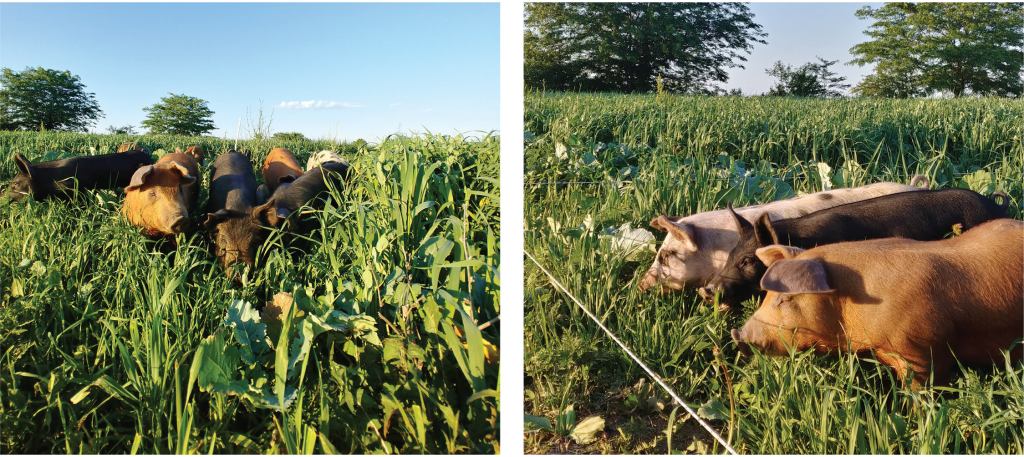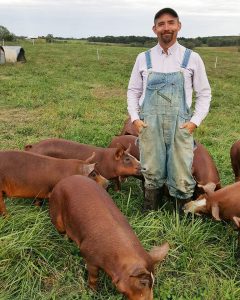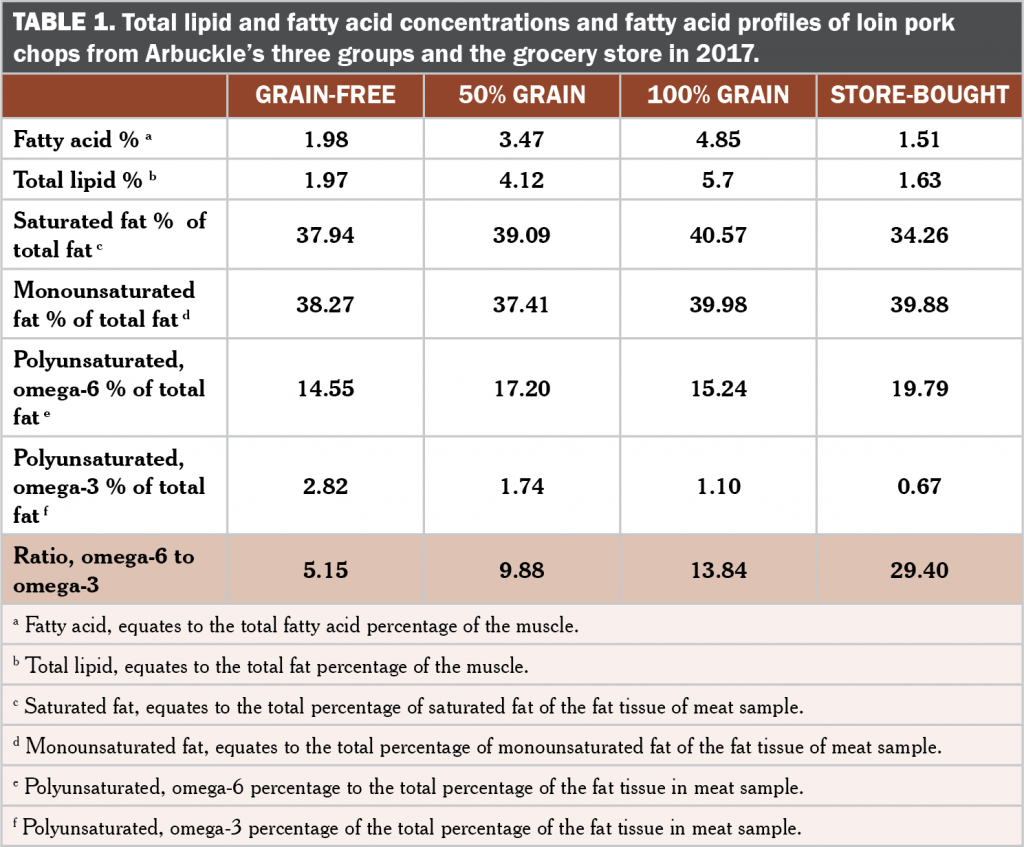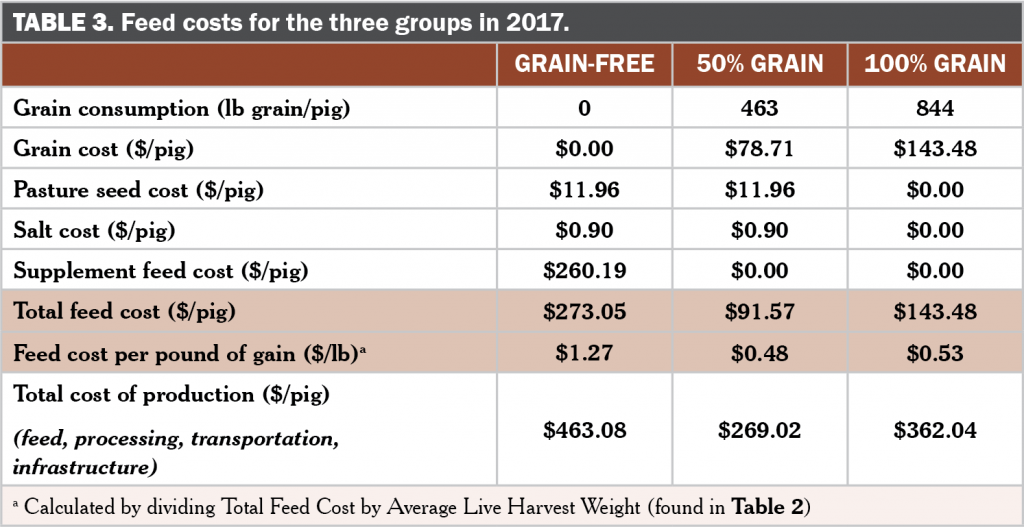In a Nutshell:
- Raising pigs on pasture increases the exposure to and intake of forages, which can affect the fatty acid composition of pork.
- Grass-fed animal fats contain higher proportions of omega-3 fatty acids than grain-fed animals. Increased human consumption of these fatty acids is known to decrease the risks of cardiovascular and autoimmune diseases.
- This demonstration study examined fatty acid composition and feed cost economics from seventy-five pigs fed three different rations: grain-free, 50% grain, and 100% grain.
Key Findings
- Pigs from the three groups had different fatty acid compositions, with varying omega-6:3 ratios. Omega-3 fatty acid concentration was greatest in the grain-free group, intermediate in the 50% grain group and lowest in the 100% grain group.
- Feed cost varied among the three groups. The grain-free group incurred the greatest costs, and took the longest to finish. While the 50% grain group resulted in the lowest costs.
- Feeding 50% grain (and 50% forage) may be ideal for reducing feed costs and achieving a fatty acid profile that could bring a higher price for pork based on consumer preference.
Background
Pigs are monogastric livestock that primarily consume grain, yet will also consume and gain weight from forage. Consumer preferences and demands are shifting towards grass- and pasture-based meats, due to perceived benefits for the environment, human health, and local economies. Pigs cannot survive solely on forages, but according to estimates, pasture can replace up to 50% of the diet in gestating sows and 30% of a finishing diet. [1,2] Increasing forage consumption can elevate the amount of “healthy” fats in meat animals.[3,4] Healthy fats are unsaturated fatty acids (UFAs), which include omega-3 fatty acids, and are known to aid in the prevention of cardiovascular and autoimmune diseases.[5]
Objective: Evaluate how grain- and forage-based diets influence the fatty acid profiles of pasture-raised pork. Farmer-cooperator, John Arbuckle was interested in assessing how rations with different grain quantities affect fat composition in pastured-pork. “An important component of this research was to see the potential nutritional benefits to human health by increasing the clovers, legumes and grasses pigs consumed,” Arbuckle said of his motivation to conduct this study.
Methods
This demonstration study was conducted by John and Holly Arbuckle, Singing Prairie Farm, in La Plata, MO from May 2017 to May 2018. Since then, the Arbuckles have moved their farm and family to Newcastle, ME. The Arbuckles raise 150 pigs a year for direct markets and their value-added snack product, Roam Sticks. Inspired by Joel Salatin’s “salad bar beef” philosophy where cows are offered multiple fresh greens to graze every day, the Arbuckles implemented similar grazing practices for pigs and coined the term “salad-bar pork” with Salatin’s permission.
This study analyzed fatty acid profiles of pastured-raised pigs on the following diets: (1) grain-free, (2) 50% grain; and (3) 100% grain. The grain-free group was comprised of 17 pigs sourced from Clear Creek Organic Farms in Nebraska and Sugar Mountain Farm in Vermont; all were Berkshire crosses. The 50% grain group was comprised of 50 pigs, and the 100% grain group was comprised of eight pigs; all were Hereford/Hampshire crosses from Arbuckle’s farm. While the 100% grain group was raised on pasture, the group was fed such that all of the pigs’ nutritional needs were met with grain.
The grain-free pigs were supplemented with organic milk powder to help meet lysine and energy requirements. The grain fed to the 50% and 100% grain groups consisted of non-GMO corn and soybean-based rations. Forages consisted of orchard grass, timothy grass, red clover, pearl millet, and cowpeas. The pigs in the grain-free and 50% grain groups were moved every 24 hours to provide access to fresh forage, while the 100% grain group was rotated every seven days to access fresh pasture.

Berkshire and Hereford/Hampshire crosses foraging on orchard grass, timothy grass, red clover, pearl millet, and cowpeas in rotating pastures.
Pigs from the three groups were harvested once they reached the desired market weights. For the grain-free group, nine were harvested out of the 17 total amount of pigs. While in the 50% grain group, all eight pigs were sent to harvest. Of the 100% grain group, four out of the 50 total amount of pigs in this group were harvested. The pig’s weights were recorded once the pigs were sent to harvest; live harvest weights were documented along with total costs of production.
Boneless center cut pork chops were sent to the Clemson University Meat Science Lab (Clemson, SC) for analysis. Eighteen loin pork chop samples from the three groups – seven from the grain-free group, seven from the 50% grain group and four from the 100% grain group – were sent for analysis. Samples were analyzed for concentrations of total lipid (fat) and fatty acids as well as a fatty acid profile: concentrations of saturated fat, monounsaturated fat and polyunsaturated fats (omega-6 and -3 fatty acids).
For comparison, Arbuckle purchased two pork chops from a local grocery store. “The store-bought pork was purchased to provide a sample representative of conventional pork to compare our pastured-based, “Arbuckle said. Only the treatment group means were reported from the lab, which precluded statistical analysis of the results. As such, only general comparisons of the numerical differences among treatment group means were made and are discussed below.
Results and Discussion
Fatty acid profiles
As the amount of grain fed decreased across all three groups of pigs, the omega-6:3 fatty acid ratios also decreased (Table 1). The 100% grain group resulted in the greatest omega-6:3 ratio (13.84); the 50% grain group was intermediate (9.88); and the grain-free group resulted in the lowest ratio (5.15).
Compared to Arbuckle’s three treatment groups and the other pasture-based farms, the store-bought pork scored a much higher (less desirable) omega-6:3 ratio of 29.40. Greater omega-6:3 ratios result from the high content of polyunsaturated omega-6 fatty acid of cereal grain-based diets.[6–8] Pigs in the U.S. and Canada are typically fed diets based on corn or small grains. In a study conducted by South Dakota State University, finishing pigs with a corn/soybean-based ration resulted pork with an omega-6:3 ratio of about 14.[9]
Arbuckle’s results suggest that feeding less grain and more forge in pig diets produces pork with lower, desired omega-6:3 fatty acid ratios. Various health organizations recommend consuming a diet with an omega-6:3 ratio of, 4, while most Americans consume a diet with an omega-6:3 ratio of 20. Diets with low omega-6:3 ratios have been recognized to reduce the risk associated with cardiovascular diseases, cancer, and inflammatory and autoimmune diseases, like diabetes.[5,10]
Total feed cost for the 50% grain group was $91.57. Dividing the total feed cost ($91.57) by the average live weight (189.25 lb) resulted in a feed cost per gain of $0.48/lb. The feed cost for the 100% grain group totaled $143.48. Considering the total feed cost ($143.48) and the average live weight (270.75 lb), the cost per pound of gain was $0.53/lb for the 100% grain pigs.
Weights and gains
Average daily gain (ADG) and average live harvest weights are shown in Table 2. The 100% grain group gained the fastest with an AGD of 1.16. The 50% grain group was fed roughly half as much grain as the 100% group (Table 3) along with large quantities of forages and achieved an ADG of 0.94. The ADG was lowest for the grain-free pigs at 0.90. The grain-free pigs consumed various forages and did consume minimal amounts of immature field peas towards the end of the spring grazing season.
Feed costs
The feed costs (Table 3) for the grain-free group include seeding for the pasture and fat-free milk powder for the pigs to meet lysine requirements. Because lysine is the first limiting amino acid in swine diet – and because of the low lysine content in forages – supplemental milk powder was offered to meet lysine requirements. Arbuckle chose to feed fat-free milk powder because it was cheaper, easier to handle and has a longer shelf life than full-fat milk powder. In Arbuckle’s opinion, the grain-free group represented the most radical departure from modern pig farming. At a rate of one pint per pig, milk powder was supplemented through the water twice a day. In total, supplementing milk powder cost $188 per pig, making the grain-free pigs the most expensive to raise with a total feed cost of $273.05. Dividing the total feed cost ($273.05) by the average live weight (212.22 lb) equals $1.27/lb, the feed cost per pound of gain for the grain-free pigs.
Conclusions and Next Steps
This demonstration trial showed how the amount of grain fed can affect fatty acid concentration in pasture-raised pork. Pigs raised on pasture with no grain produced the lowest omega-6:3 fatty acid ratio. This group was by far the most expensive group to feed, though, due to the need for supplemental feed (milk powder) in order to meet the pigs’ amino acid nutritional needs. The 50% reduced grain group resulted as the most economical to feed and produce across the three groups. “The 50% reduced grain group hits the sweet spot for farmers trying to reduce the amount of grain fed and overall feed costs, while justifying a higher price point for pork,” Arbuckle said of the results. Though the 50% grain group did not result in the lowest (best) omega-6:3 ratio among the three groups of pigs, the resulting ratio (9.33) was roughly one-third that of the pork chop sourced from the grocery store (29.40) (Table 1).
John and Holly Arbuckle’s mission is to, “fill the countryside with ecologically-sensitive, pasture-based family farmers.” The increasing awareness of the need for human diets with lower omega-6:3 ratios was a major driver for the Arbuckles to conduct this study. For the Arbuckles, this project builds upon their mission to raise pastured pigs, and investigate how pastured pigs on different feed systems could meet ideal market performance. John added, “This project was undertaken to evaluate the feasibility of three different feed management systems. We hope that farmers who read this study will have a greater understanding of what can happen when you lower the amount of grain in pig rations.”
References
- Harper, T., T. Frantzen and S. Dave. 2007. Organic Hog Production.
- O’Meara, B. 2002. Small scale pastured hog production. GrassWorks Grazing Guide. 51–55. https://grassworks.org/wp-content/uploads/2016/11/Guidebook.Hog-Production.pdf (accessed March 2019).
- Ponte, P.I.P., S.P. Alves, R.J.B. Bessa, L.M.A. Ferreira, L.T. Gama, J.L.A. Brás, C.M.G.A. Fontes and J.A.M. Prates. 2008. Influence of Pasture Intake on the Fatty Acid Composition, and Cholesterol,Tocopherols, and Tocotrienols Content in Meat from Free-Range Broilers. Poultry Science. 87:80–88. https://academic.oup.com/ps/article-abstract/87/1/80/1567071 (accessed March 2019).
- Daley, C.A., A. Abbott, P.S. Doyle, G.A. Nader and S. Larson. 2010. A review of fatty acid profiles and antioxidant content in grass-fed and grain-fed beef. http://www.nutritionj.com/content/9/1/10 (accessed March 2019).
- Dugan, M., P. Vahmani, T. Turner, C. Mapiye, M. Juárez, N. Prieto, A. Beaulieu, R. Zijlstra, J. Patience, J. Aalhus, M.E.R. Dugan, P. Vahmani, T.D. Turner, C. Mapiye, M. Juárez, N. Prieto, A.D. Beaulieu, R.T. Zijlstra, J.F. Patience and J.L. Aalhus. 2015. Pork as a Source of Omega-3 (n-3) Fatty Acids. Journal of Clinical Medicine. 4:1999–2011. http://www.mdpi.com/2077-0383/4/12/1956 (accessed March 2019).
- Wood, J.D., M. Enser, A. V Fisher, G.R. Nute, P.R. Sheard, R.I. Richardson, S.I. Hughes and F.M. Whittington. Fat deposition, fatty acid composition and meat quality: A review. www.elsevier.com/locate/meatsci (accessed March 2019).
- Gatlin, L.A., M.T. See, J.A. Hansen, D. Sutton and J. Odle. 2002. The effects of dietary fat sources, levels, and feeding intervals on pork fatty acid composition 1. J. Anim. Sci. https://pdfs.semanticscholar.org/a1c0/9e1d7685fc239802b316d1de608ea163f72e.pdf (accessed March 2019).
- Raes, K., S. De Smet and D. Demeyer. 2004. Effect of dietary fatty acids on incorporation of long chain PUFA and CLA in lamb, beef and pork meat. A review. Animal Feed Science and Technology. 113:199–221. https://www.sciencedirect.com/science/article/pii/S0377840103002530?via%3Dihub (accessed March 2019).
- Romans, J.R., D.M. Wulf, R.C. Johnson, G.W. Libal and W.J. Costello. 1995. Effects of Ground Flaxseed in Swine Diets on Pig Performance and on Physical and Sensory Characteristics and Omega-3 Fatty Acid Content of Pork: II. Duration of 15% Dietary Flaxseed. Journal of Animal Science. 73:1987–1999. https://academic.oup.com/jas/article-abstract/73/7/1987/4718835 (accessed March 2019).
- Simopoulos, A.P. 2008. The Importance of the Omega-6/Omega-3 Fatty Acid Ratio in Cardiovascular Disease and Other Chronic Diseases. Experimental Biology and Medicine. 233:674–688. http://www.iom.edu/CMS/3788/4574.aspx (accessed March 2019).





